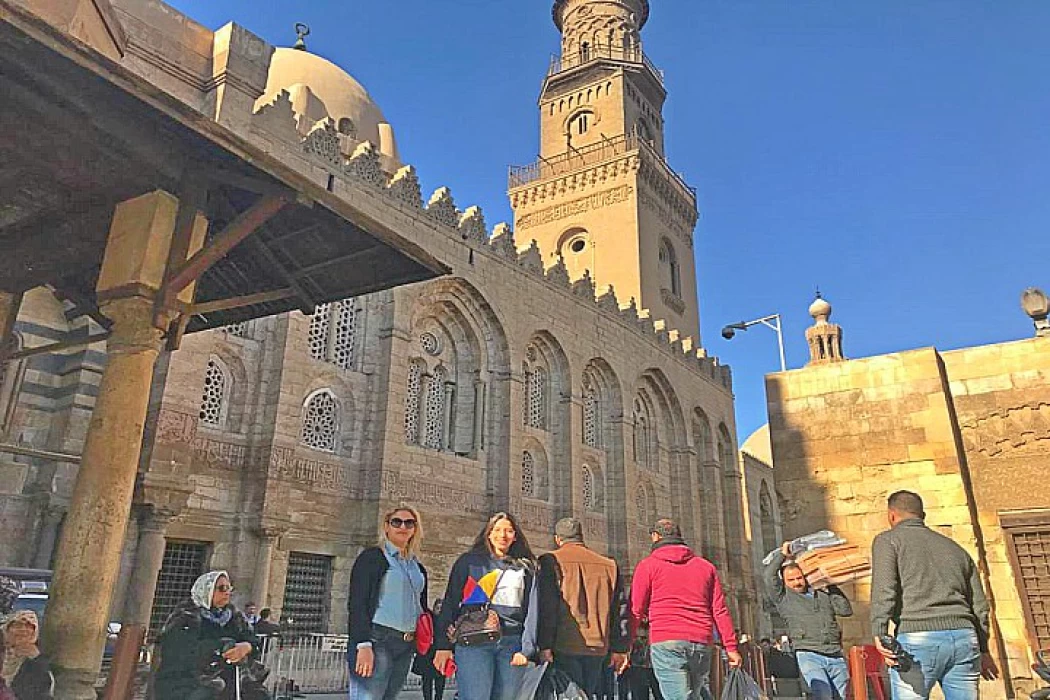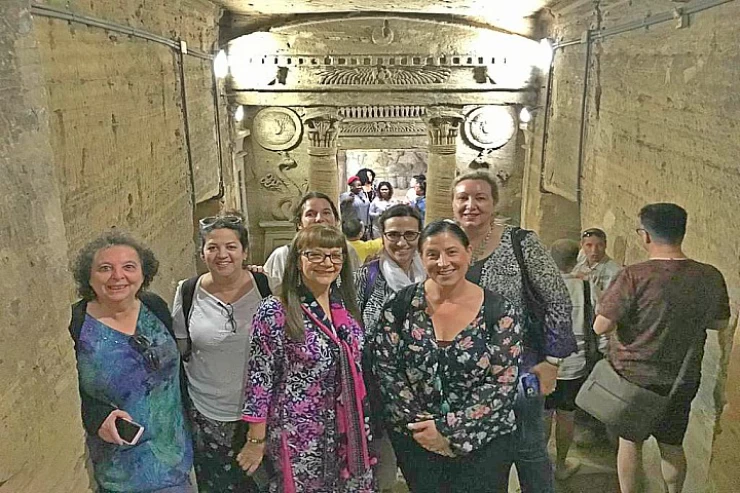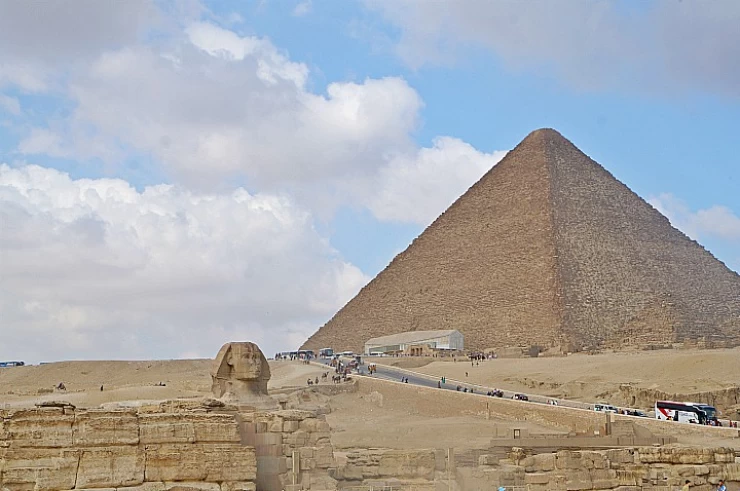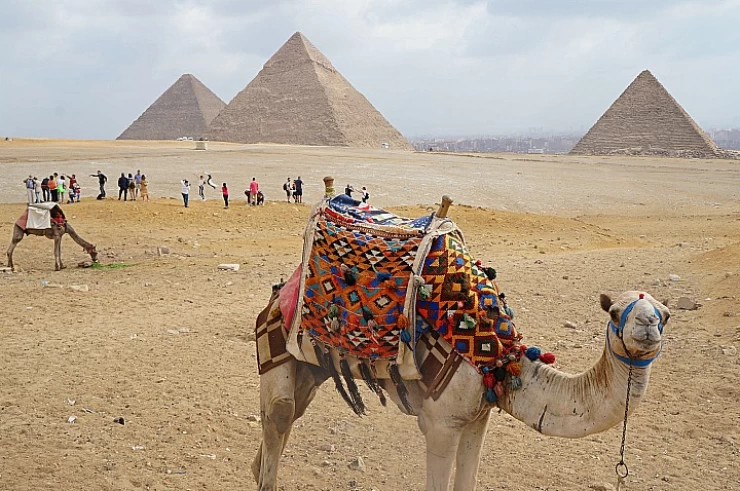
El Moez 街
探索开罗El Moez街的历史魅力。
位于开罗市中心的埃尔莫埃斯街,是埃及历史的一个华丽的时间胶囊。 El Moez街,被许多人称为Al-Muizz li-Din Allah街,是一个非凡的短语,使人们能够穿越伊斯兰历史的走廊,这些走廊丰富了中世纪伊斯兰时期的一些最好的例子,可能 在这个地方,历史时代和现代快节奏的开罗城市和谐地结合在一起,给人一种旅行到不同时代的感觉。
埃尔莫埃斯街的历史意义
这条街以Al-Muizz li-Din Allah命名,是第四位法蒂玛哈里发的颂歌,他在10世纪构想了开罗市。 这条街道原本打算代表新城市的支点,后来发展成为中世纪克罗地亚小镇的中心街道之一,充满了房屋,清真寺和市场大厅。 埃尔莫埃斯街保留了这段历史的痕迹,几个世纪以来,开罗成为行政中心,后来成为商业中心。
此外,它仍然是开罗最古老的路段之一,它有一些历史建筑得到了很好的保存。 沿着El Moez街走,感觉就像是穿过一个开放的艺术博物馆,讲述了埃及伊斯兰艺术时期的故事,从10世纪持续到17世纪。 这条街可以证明开罗辉煌的过去,它是不同文化的熔炉,也是这条街众多迷人的建筑特征之一,使它成为世界上最美丽的内城街。
埃尔莫埃斯街的建筑奇迹
El Moez街的特点是广泛的建筑作品,包括各种伊斯兰帝国的建筑,如法蒂玛,马穆鲁克和奥斯曼文明。 每个结构都是独特的,有详细的装饰和它的文化历史。 以下是您在街上散步时不应错过的一些亮点:
爱资哈尔清真寺
阿资哈尔清真寺虽然稍微远离主要街道,但步行即可到达,它是伊斯兰世界最古老,最受尊敬的崇拜中心之一。 这座清真寺建于公元970年,以伊斯兰文化中心艾资哈尔为主,有着相当长的历史,以其令人难以置信的设计而闻名。 尖塔优雅,清真寺的庭院广阔。
哈基姆清真寺
Al-Hakim清真寺致力于Al-Hakim bi-Amr Allah,他在东方统治了一段时间。 这座大厦是在法蒂玛帝国繁荣的短暂时期建造的,是法蒂玛建筑的一个例子。 它有巨大的尖塔,一个宏伟的祈祷场所,以及建于11世纪的装饰拱顶,景观和走廊。 这座清真寺即使在其历史过程中经历了几次修复后仍然完好无损,它设法保留了旧卡姆的历史部分,因此它仍然为后代保留。
Sabil-Kuttab:Katkhuda建筑群内的18世纪建筑
这座非凡的建筑可以追溯到18世纪,是奥斯曼风格建筑的典型例子。 "帆"是一个圆顶,人们可以免费获取饮用水,而"kuttab"则是教孩子们古兰经的地方。 这座建筑的天花板装饰精美,用大理石、瓷砖和其他材料装饰,吸引了许多人的注意,使它成为拍照的好地方。
Qalawun基金会
其中最引人注目的建筑空间,包括清真寺,宗教学校和机构,是Qalawun综合体。 该建筑群建于13世纪苏丹Qalawun时代。 它是典型的马穆鲁克的建筑风格。 这座机构建筑的艺术复杂性是无法理解的,拥有令人惊叹的复杂木制品,石头和大理石作品,以及美丽的圆顶。
Al Suhaymi之家
这座房子已经完全恢复了奥斯曼帝国时期的辉煌,展示了一位繁荣的17世纪商人的生活。 这所房子--Bayt Al-Suhaymi--配有木制网窗、一个美丽的内花园和巧妙装饰的室内标志,带有古老开罗魅力的气息。
Khan El-Khalili市场
Khan El-Khalili距离El Moez街仅有几米之遥,这是一个允许游客购买正宗埃及商品的市场,如珠宝,香料,布料,古董等等。 充满了色彩,窒息的气味,充满了喊叫和噪音—这是市场,人们来购买和出售。
体验街道的文化氛围。
埃尔莫埃斯街不仅是一座并排矗立的历史建筑,也是一个充满活力的地方,全年都有当地人和游客的活动。 全年,这条街以艺术,戏剧,音乐,民间传说和其他形式的娱乐形式体验不同的文化。
当你在街上漫步时,你会看到演奏埃及传统音乐的音乐家、工作中的艺术家,空气中弥漫着沙拉三明治、犹太洁食等街头食品的香气,还有巴斯布萨和科纳法等甜点。 夜幕降临时,灯笼和彩灯在点缀街道时被打开,使街道变得美丽迷人。
Tannoura舞蹈表演是El Moez街最受欢迎的活动之一。 这是一个苏菲崇拜舞蹈,是由训练有素的苦行僧在多色裙子的传统音乐。 这是一个令人愉快的经历,一个人必须见证。 这种表演通常发生在Wekalet El Ghouri,这是一个古老的大篷车,最近被用作文化中心。
参观El Moez街的秘诀
最佳游览时间:游览埃尔莫兹街的最佳时间是在一天的凌晨或晚上,当时天气相对凉爽,适合摄影。 人们也可以通过参观街道来欣赏夜晚的荣耀,街道上有不同的迷人的灯光氛围。
导游:为了完全沉浸在城市建筑的文化中,您想聘请当地导游。 这些专业人士将解释每个结构的天才位及其所有历史。
穿着保守:因为你将参观众多的礼拜场所,你可能想要穿着保守。 因此,妇女进入清真寺时应携带围巾或披肩遮住头部。
摄影:大多数地方允许拍照,但在点击相机之前先寻求许可总是很好的,特别是在教堂这样的地方。
喝水:开罗的天气有时会很热,因此,建议你在沿街旅行时带一些水。
埃尔莫埃斯街:穿越时间的旅程
沿着埃尔莫兹街走就像翻阅一本历史书。 这是一个地方,每个砖或结构都有一个故事要讲,使它成为一个活生生的历史。 一些人可能对历史感兴趣,另一些人对建筑感兴趣,还有一些人可能只是想享受开罗市,但当他们访问埃尔莫埃斯街时,所有人都会带着难忘的经历离开。
埃尔莫埃斯街无疑是体验开罗真正本质的最佳地点之一,这要归功于它的建筑、文化和历史。 所以,穿上你最好的步行鞋,携带你最好的相机,并准备自己走在宇宙中最古老和美丽的街道之一。
深入了解埃尔莫兹街的历史
埃及首都的大多数游客都认为,该地区最古老的街道之一El Moez St.是一件永恒的艺术品。 El Moez St.是在公元x世纪由Al-Fatimiyun作为开罗基础的一部分奠定的。 它最初被设想为径向城市的主要径向,从bab Zuwila的南部大门到bab Al-Futuh和Bab Al-Nasr的北部大门。 许多世纪以来,它适应了许多伊斯兰苏丹国的统治,如Ayyubids,Mamluks和Ottomans,每个人都留下了不同的建筑和传统。
在社会和经济方面,El-Moez街是经历了足够发展的街道之一。 由于它的地理位置,它被认为是一个文化的十字路口和繁忙的商业中心。 从中东,非洲,甚至欧洲的每个角落旅行的人都会来到这些街道的居民那里出售他们的商品—香料,织物和各种商品。 街道的设计和大部分建筑都与伊斯兰开罗的辉煌故事相呼应,讲述了辉煌的故事,让人们可以窥视这个地方的华丽历史。
规划您的访问:实用技巧
到达那里
从开罗的各个方向很容易到达El Moez街。 乘坐地铁到Bab El Shaaria或Ataba站,如果使用公共交通工具,然后步行到街道的入口。 否则,出租车或私家车是更好的选择。
探索附近景点
如果你得到一些空闲时间,探索附近的地区是你可以考虑的选择。 Al Azhar公园是一个维护良好的绿色公园,可以欣赏到开罗的壮丽景色,其历史近在咫尺,或者您可以参观另一个地区伊斯兰开罗,该地区以苏丹哈桑清真寺和Al-Rifa'i清真寺等其他着名景点而闻名。
食物及茶点
许多街头食品供应商也可以在El Moez街找到,因为这可以让人们品尝一些相当当地的埃及小吃。 如果你喜欢悠闲的用餐,传统的咖啡馆和餐馆可以提供像ful medames,ta'ameya或由鸽子组成的填充食物。 可以作为甜点供应的许多埃及菜肴之一包括atayef和muhallabia。
购物小贴士
在开罗的市场上到处讨价还价是很常见的. 因此,不要回避讨价还价。 沿着El Moez街有许多商店,有许多手工工艺品,珠宝和纺织品,可以作为纪念品购买。 从供应商那里购买当地工艺品非常重要,因为它有助于促进和保护这些工艺品不会消失。
走过埃及的黄金时代
El Moez街不仅仅是观光。 一个人去旅行,沉浸在埃及所夸耀的历史中. 它充满了人民的历史、艺术和文化。 人们对这座历史名城有所了解,它是如何充满古老的通道,高耸的尖塔,街道上阿丹号的声音等等。 人们不禁钦佩这座城市过去的丰富和继续存在的精神。 无论一个旅行者是一个历史爱好者,一个文化探索者,或者只是一个想要一个美好的旅行的人,总有一些东西在埃尔莫埃斯街为每个人。
Discover the historic charm of El Moez Street in Cairo.
Located deep in the city of Cairo, one can find El Moez Street, a gorgeous time capsule of Egyptian history. El Moez Street, known to many as Al-Muizz li-Din Allah Street, is a remarkable phrase that enables one to traverse the corridors of Islamic history enriched by some of the best examples of the medieval Islamic period, perhaps many mosques, dry and wet bazaars, and a variety of other experiences. In this place, there is a harmonious combination of the historical age and the contemporary, fast-paced city of Cairo, leaving one with the feeling of having traveled to a different era.
The Historical Significance of El Moez Street
Named after Al-Muizz li-Din Allah, the street is an ode to the fourth Fatimid Caliph, who conceived the city of Cairo in the 10th century. The street, originally intended to represent the fulcrum of the new city, later developed into one of the central streets of the medieval Croatian town, filled with houses, mosques, and market halls. El Moez Street retains traces of this history, having changed over centuries as Cairo became an administrative center and later, a commercial center.
Moreover, it is still among the oldest stretches of way in Cairo, which has some historic structures that have been very well preserved. Walking along El Moez Street feels as though one is traversing an open museum of art that tells the story of Egypt’s Islamic Art period, which lasted from the 10th century to the 17th century. The street can support attestation of Cairo’s illustrious past, where it served as a melting pot for different cultures and one of the many fascinating architectural attributes of the street, making it the world’s most beautiful intracity street.
Architectural Marvels Along El Moez Street
El Moez Street is characterized by a wide range of architectural works that include buildings from various Islamic Empires, such as the Fatimid, Mamluk, and Ottoman civilizations. Each structure is unique with detailed decoration and its cultural history. Here are some of the highlights that you should not miss while walking down the street:
Al Azahar
Though slightly tucked away from the main street, Al-Azhar Mosque is just within walking distance, and it is one of the oldest and most revered centers of worship located in the Islamic World. Constructed in 970 A. Dominated by the center of Islamic culture, Al-Azhar, for quite a few ages, this mosque is remarkable for its incredible design. The minarets are elegant, and the mosque’s courtyard is vast.
Al-Hakim Mosque
Al-Hakim Mosque is dedicated to Al-Hakim bi-Amr Allah, who ruled in the East for some time. This edifice was built during the short period when the Fatimid Empire flourished and is an example of Fatimid architecture. It has giant minarets, a grand prayer place, and decorated vaults, landscapes, and corridors built in the 11th century. This mosque is still intact even after undergoing several restorations in the course of its history, which has managed to keep the historical part of Old Kam, so it is still preserved for the coming generations.
Sabil-Kuttab: an 18th-century structure within the Katkhuda complex
This remarkable building dates back to the 18th century and is a typical example of Ottoman-styled structures. A “sail” is a dome where people fetch drinking water free of charge, while a “kuttab” is a place for teaching the children the Quran. The elaborately decorated ceiling of the building, embellished in marble, tiles, and other materials, draws the attention of many people, making it a great site for taking photographs.
Qalawun Foundation
Among the most remarkable exercises of architecturally constructed space, which embraces a mosque, a madrasa, and an institution, is the Qalawun complex. The complex was built during the era of Sultan Qalawun in the 13th century. It is typical of Mamluk's architectural style. The artistic complexity of this institutional building is beyond comprehension, having stunning intricate woodwork, stone, and marble work, as well as beautiful domes.
Home of Al Suhaymi
The house has been fully restored to its glory during the Ottoman period, showcasing the life of a prosperous 17th-century merchant. The house to this – Bayt Al-Suhaymi – comes with wooden mesh windows, a beautiful inner garden, and skillfully decorated interior signs that carry the touch of the old Cairo charm.
Situated a few meters from El Moez Street is Khan El-Khalili, a marketplace that allows tourists to buy authentic Egyptian goods, such as jewelry, spice, cloth, antiques, and much more. Filled with colors, choking with scents, filled with shouting and noise—this is the market, where people come to buy and sell.
El Moez Street is not only a great number of historical edifices standing side by side, but also a lively place full of activity for the natives and visitors around the year. Throughout the year, this street experiences different cultures in the form of arts, theater, music, folklore, and other forms of entertainment.
As you stroll through the street, you’ll find musicians playing Egyptian traditional music, artists at work, and the aroma of street foods such as falafel, koshari, and desserts like basbousa and konafa fills the air. As night falls, lanterns and colored lights are turned on as they embellish the street, making it attractive turned beautiful.
The Tannoura Dance Show is among the most done activities along El Moez Street. This is a Sufi worship dance that is performed by trained dervishes in multicolor skirts to the traditional music. This is an enjoyable experience that one has to witness. This performance normally happens at Wekalet El Ghouri, which is an old caravanserai recently used as a cultural center.


















